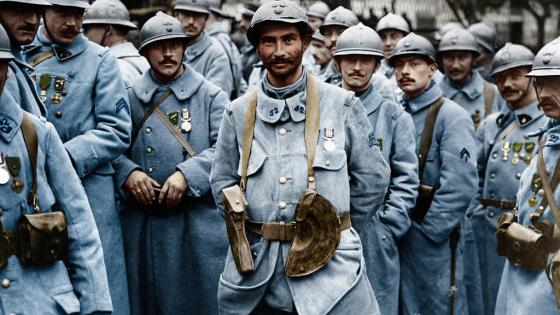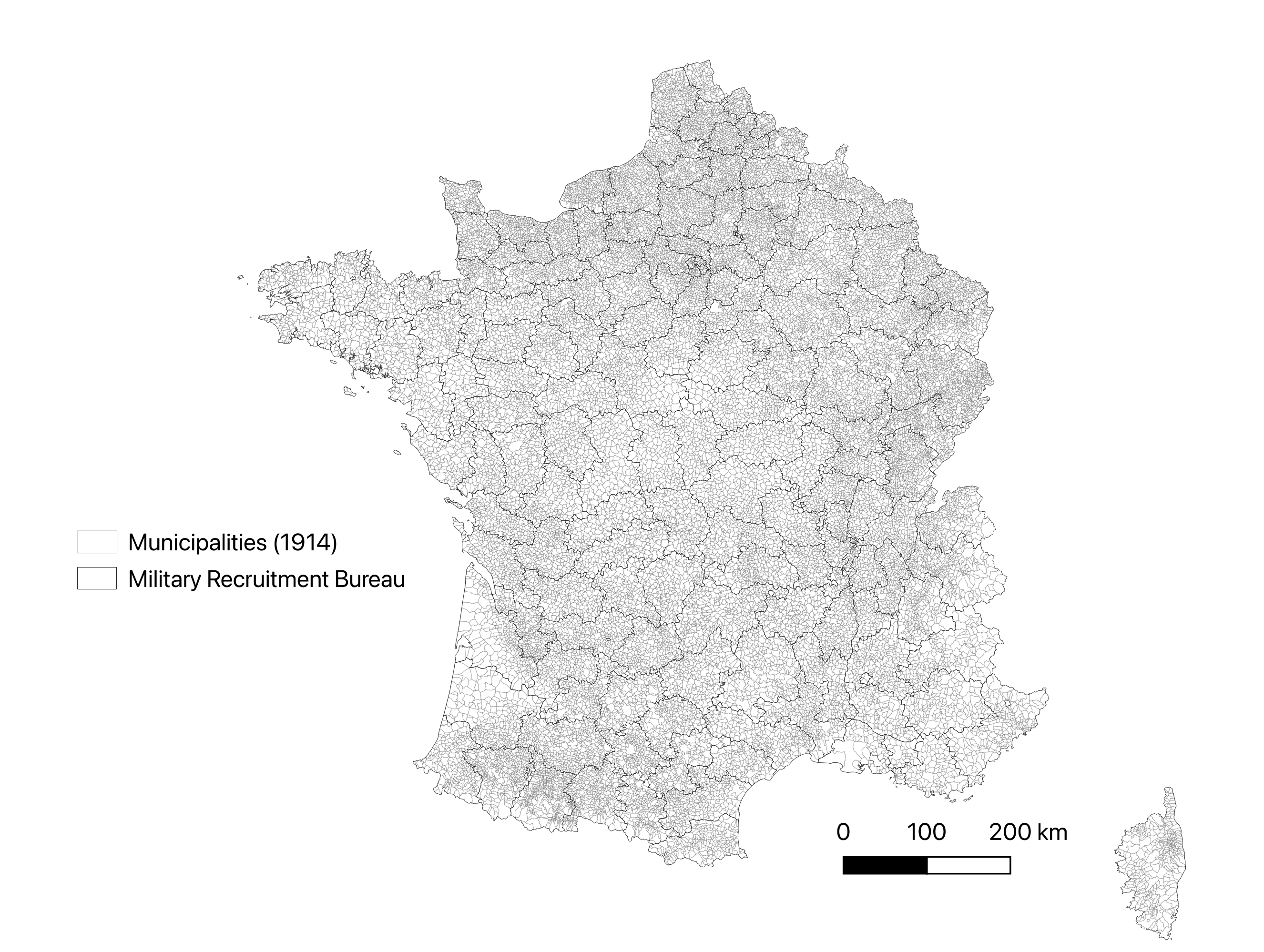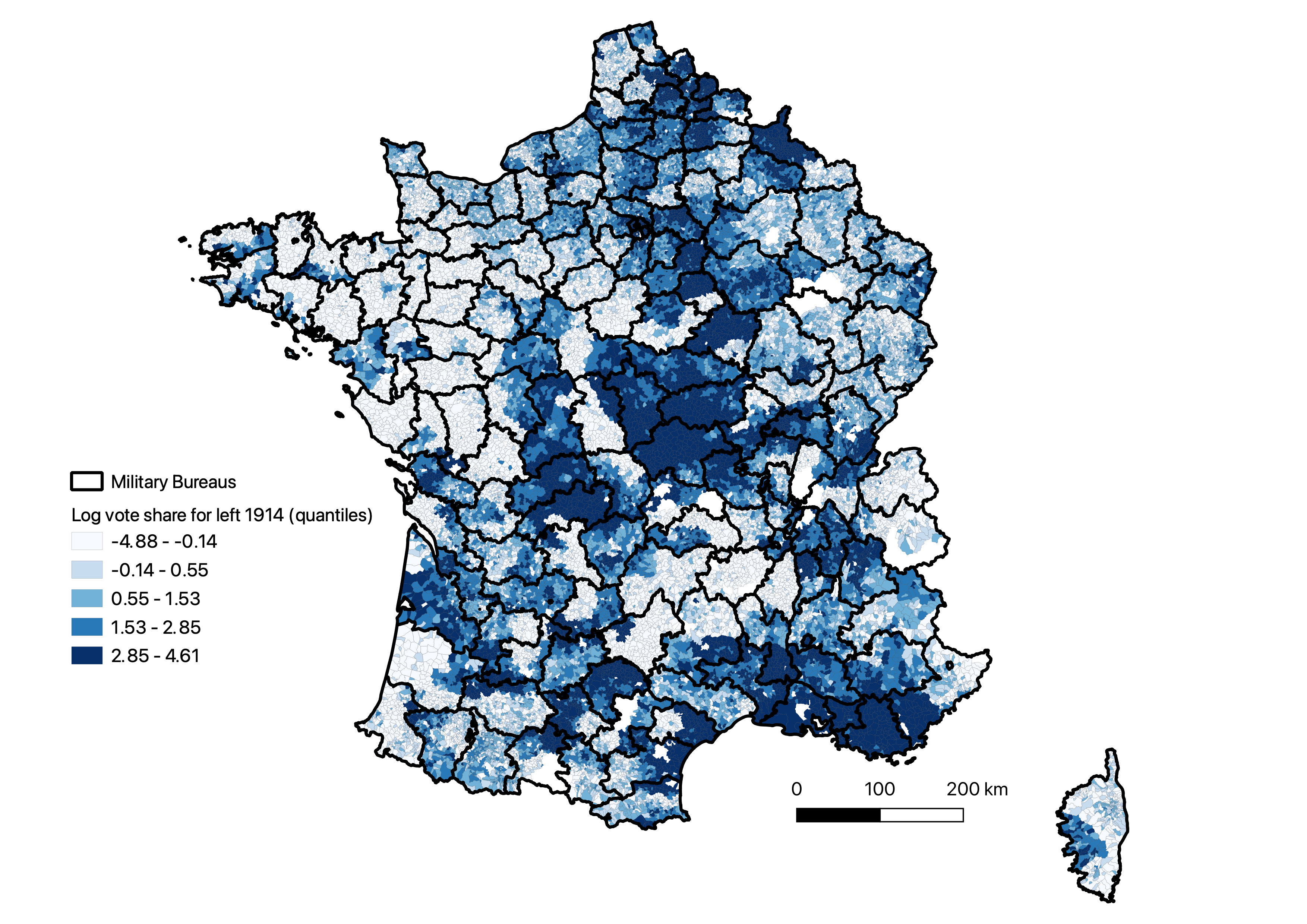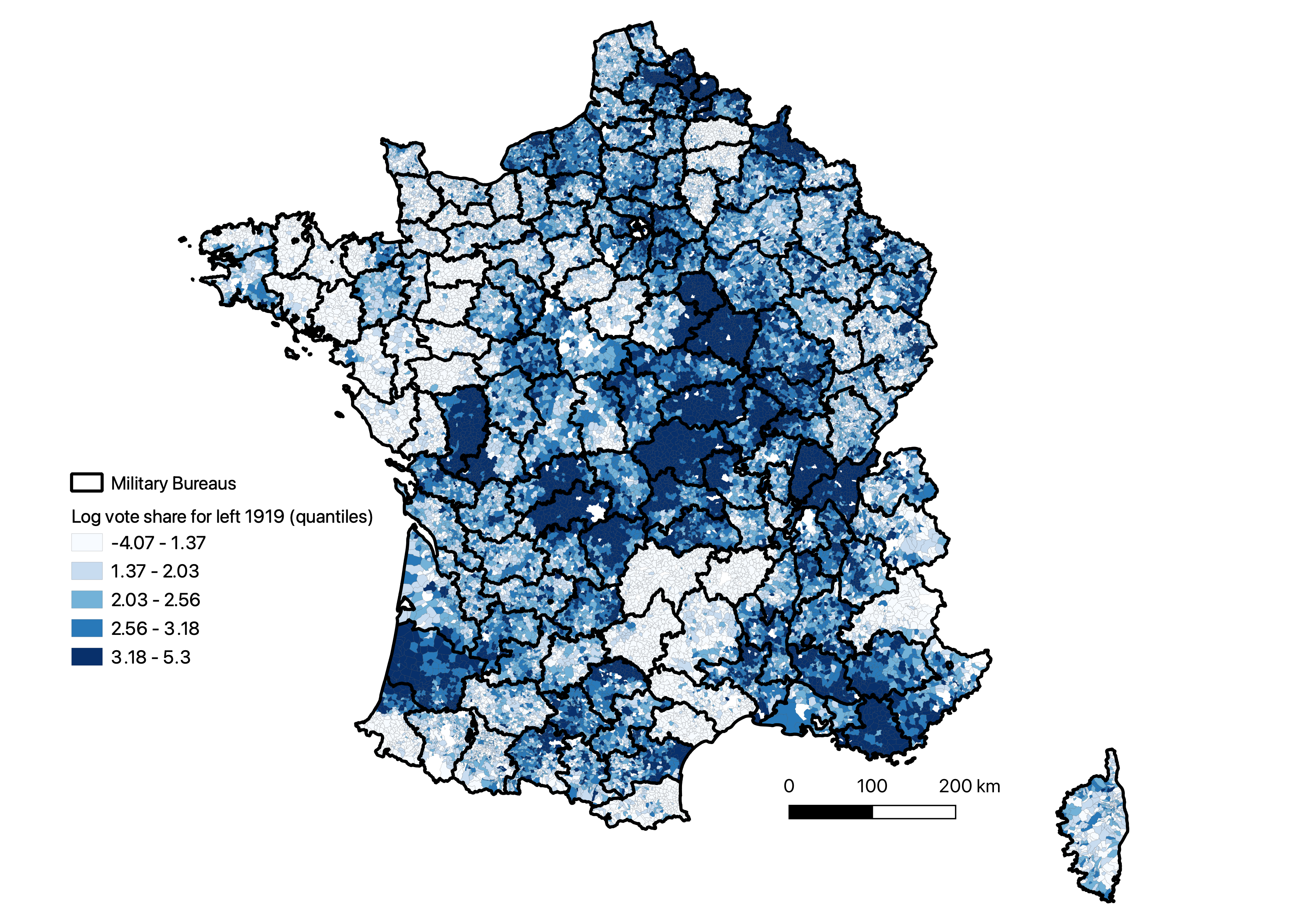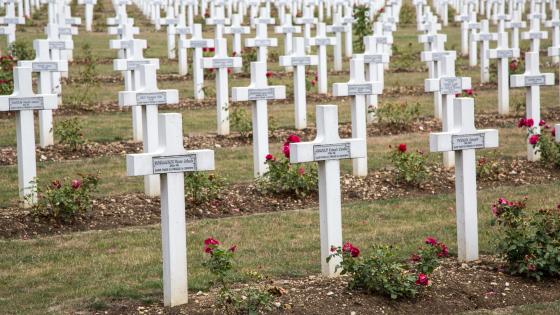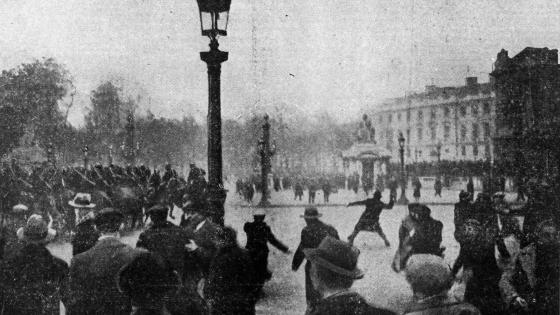From Brexit to the Capitol riots, political polarisation has emerged as a looming threat to the stability of liberal democracies (Sunstein 2009, Tabellini and Gennaoili 2019, Rohner and Zhuravskaya 2023). Polarisation not only fosters prejudice and hostility between groups (Iyengar and Westwood 2015) but at its extreme, has the potential to escalate into violence and civil war (Montalvo and Reynal-Querol 2005, Esteban and Ray 2008, Corvalan and Vargas 2015, Klašnja and Novta 2016). Yet, teasing out the causes of polarisation remains a challenge, particularly as voters increasingly tend to segregate themselves, both geographically (Bishop and Cushing 2009, Brown and Enos 2021) and within information bubbles (Gentzkow and Shapiro 2011, Levy and Razin 2019, Levy 2021).
In a recent study, we shed new light on the causal connections between local segregation, partisanship, and political polarisation, drawing upon the unique historical context of France’s military recruitment during WWI (Grosjean et al. 2024). Our findings reveal that soldiers who fought side by side in the same WWI line regiment tended to converge in their post-war vote choices to the prevailing political views within their regiment. This suggests that the WWI battlefield served as a fertile ground for the ‘horizontal transmission’ of new political ideas. The concept of shared wartime experiences forging lasting bonds of solidarity is aptly encapsulated by the French term: the esprit de corps.
Fighting alongside ideologically committed left-wing comrades in the high-stakes environment of the battlefield could be highly persuasive. Service in the same regiment provided an environment where the hammer (industrial workers) and sickle (agricultural workers) were compelled to depend upon and trust one another.
Our results show that (mostly relatively poor) soldiers from rural municipalities exposed to more left-leaning regiments embraced leftist ideologies for the first time after the war, while those from adjacent rural municipalities assigned to right-wing regiments appear to become inoculated against the persuasive redistributive platform of the left. These differences likely reflect persuasive information exchange among peers when cooperation and trust are crucial, rather than mere group conformity.
But the story does not end there. Importantly, our analysis shows that these differences manifested not only in voting patterns but also in violent civil conflicts between collaborators and members of the Resistance during WWII, highlighting the far-reaching impact of these wartime divisions.
The historical context: France’s WWI military assignments
The impact of WWI in France was profound. By the end of the war, nearly 8 million French troops had served, with a staggering toll of more than 1.3 million military fatalities (Gay and Grosjean 2023a,b). This vast mobilisation effort relied on a structured military recruitment system, which forms the backdrop of our study. France was divided into 20 Army-corps military regions, and each region was further divided into subregions corresponding to local recruitment bureaus, which formed infantry regiments. This recruitment system, illustrated in Figure 1, brought together people from diverse backgrounds, influencing their political views, and ultimately shaping the broader national landscape in the interwar period.
Figure 1 The territorial organisation of the French Army in 1914: Municipalities’ assignment to recruitment bureaus for the line infantry
Notes: Municipalities (N=34,947) within France’s 1914 borders and recruitment bureaus (N=158), from Baron and Lassalle (1915).
The local roots of polarisation
France held elections in the spring of 1914 just before the outbreak of WWI, which captured the pre-war political landscape. The Socialist Party (SFIO), under its pacifist leader, Jean Jaurès, emerged as a major political force, gathering 15.84% of the vote. The first post-war elections were held in November 1919. Figure 2 presents the legislative election results at the municipality level overlaid with the boundaries of military recruitment bureaus at the start of WWI. The figure illustrates how four years of trench warfare radically changed France’s electoral map, with voting becoming much more homogeneous within a recruitment bureau by 1919. In other words, although two municipalities drafted in the same regiment in WWI were not more likely to vote in a similar fashion before the war, they were more likely to do so after the war. This transformation suggests that the shared regimental history during the war built political solidarity, leading to a reduction in polarisation within regiments.
Figure 2 Vote for the left in the 1914 and 1919 elections and WWI military recruitment bureaus
(a) 1914
(b) 1919
Notes: This figure shows the (quantiles of the) share of left-wing votes in the 1914 (N=33,725 municipalities) and in the 1919 elections (N=33,680 municipalities) overlaid with the 1914 military recruitment bureaus.
Political dynamics post-WWI
The left emerged as a new political force during this period, redefining politics and exposing many (rural) municipalities to its ideology for the first time due to regimental assignment. But did these shared experiences influence political leanings? Estimating the causal impact of regiment-level peers on partisan shifts in political attitudes is particularly challenging (Manski 1993). A key concern is that municipalities assigned to left-leaning regiments might have already been inclined towards left ideas, regardless of wartime exposure.
The ideal setting to address this is to compare geographically proximate municipalities with no prior left-wing presence that happened to be assigned to regiments with vastly different political compositions. Our analysis approximates this scenario by exploiting local discontinuities in regimental assignment across 435 military boundaries, using a spatial regression discontinuity framework. We do so by linking each of the 37,947 municipalities, our unit of analysis, to their original military recruitment bureau.
Our analysis reveals a striking difference: exposure to a socialist regiment led to a significant jump in socialist votes after the war, ranging from 26% to 37% on average. In contrast, exposure to a right-wing regiment reduced left-wing votes. However, the decrease in left-wing votes primarily benefitted the centre, not the right. Importantly, these differences endured throughout the interwar elections and even persisted into the post-WWII elections, demonstrating the lasting impact of wartime experiences.
Why left and right impacted votes differently
Why did exposure to left-wing and right-wing regiments have distinct effects on voting behaviour? The answer can be traced back to the pre-existing political landscape in France. Right-wing parties were firmly established before the outbreak of WWI, especially in rural areas. In contrast, leftist ideologies were relatively novel in many parts of the country.
This explains the distinct impact of wartime exposure. When exposed to peers in a left-wing regiment, agricultural soldiers from less wealthy backgrounds encountered new ideas about redistribution and equality that resonated with them and potentially swayed their votes. However, when exposed to majority right-wing comrades, they were instead dissuaded from voting for the left because of exposure to counterarguments posed by conservatives, including perspectives on social and religious issues.
Beyond electoral outcomes: Violent consequences
Extending our analysis beyond electoral results, we illustrate some of the devastating consequences of this local polarisation: violent civil conflict during WWII. The interwar period was followed by the collapse of France’s longest-lived democratic republic and the rise of the authoritarian Vichy regime that collaborated with Nazi Germany (Lacroix et al. 2019, Cagé et al. 2023). The Vichy regime, led by WWI military hero and Marshal of France Philippe Pétain aggressively targeted perceived internal enemies, including leftists and members of the Resistance. These conflicts are connected to the rise in interwar polarisation that took root in WWI.
While WWI fostered political homogenisation within regimental catchment areas, it also, in numerous cases, generated sharp post-war differences in partisan voting behaviour – that did not exist previously – between spatially adjacent rural municipalities that happened to be assigned to different (partisan) regiments. This sharp division had further consequences. Analysing detailed police and Gestapo files on Resistance activities, we find increased activity by the Resistance along the boundaries of WWI military recruitment bureaus, but only when these boundaries coincided with sharp local discontinuities in partisanship. This heightened activity involved civilian targets, indicating the civil war nature of these local conflicts.
Conclusions
Our exploration of France’s interwar and wartime history demonstrates how social interactions can shape political preferences and exacerbate polarisation across communities, potentially leading to violence. The patterns we document, unfortunately, resonate with modern societies, where individuals increasingly choose to interact with like-minded peers, amplifying polarisation (Zhuravskaya et al. 2020). Our study suggests that such segregation and polarisation can have far-reaching consequences, even potentially escalating into violence and civil war.
References
Baron, C, and C Lassalle (1915), Dictionnaire des communes, administratif and militaire.
Bishop, B, and R G Cushing (2009), The big sort: Why the clustering of like-minded America is tearing us apart, Houghton Mifflin Harcourt.
Brown, A R, and R D Enos (2021), “The measurement of partisan sorting for 180 million voters”, Nature Human Behaviour 5(8): 998–1008.
Cagé, J, A Dagorret, P Grosjean, and S Jha (2023), “Heroes and villains: The effects of heroism on autocratic values and Nazi collaboration in France”, American Economic Review 113(6): 1888–932.
Esteban, J, and D Ray (2008), “Polarization, fractionalization and conflict”, Journal of Peace Research 45(2): 163–82.
Gay, V, and P Grosjean (2023a), “New scores on old sores: The Morts pour la France database on WWI fatalities in France”, VoxEU.org, 29 August.
Gay, V, and P Grosjean (2023b). “Morts pour la France: A database of French fatalities of the Great War”, Explorations in Economic History 90: 101550.
Gentzkow, M, and J M Shapiro (2011), “Ideological segregation online and offline”, Quarterly Journal of Economics 126(4): 1799–839.
Grosjean, P, S Jha, M Vlassopoulos, and Y Zenou (2024), “Political trenches: How WWI shaped France’s political landscape”, CEPR Discussion Paper 18721.
Iyengar, S, and S J Westwood (2015), “Fear and loathing across party lines: New evidence on group polarization”, American Journal of Political Science 59(3): 690–707.
Klašnja, M, and N Novta (2016), “Segregation, polarization, and ethnic conflict”, Journal of Conflict Resolution 60(5): 927–55.
Lacroix, J, P-G Méon, and K Oosterlinck (2019), “A positive effect of political dynasties: The case of France’s 1940 Enabling Act”, CEPR Discussion Papers 13871.
Levy, R (2021), “Social media, news consumption, and polarization: Evidence from a field experiment”, American Economic Review 111(3): 831–70.
Levy, G, and R Razin (2019), “Echo chambers and their effects on economic and political outcomes”, Annual Review of Economics 11: 303–28.
Manski, C F (1993), “Identification of endogenous social effects: The reflection problem”, Review of Economic Studies 60(3): 531–42.
Montalvo, J G, and M Reynal-Querol (2005), “Ethnic polarization, potential conflict, and civil wars”, American Economic Review 95(3): 796–816.
Rohner, D, and E Zhuravskaya (eds) (2023), Nation building: Big lessons from successes and failures, CEPR Press.
Sunstein, C R (2009), Going to extremes: How like minds unite and divide, Oxford University Press.
Tabellini, G and N Gennaoili (2019), “Identity, beliefs, and political conflict”, VoxEU.org, 6 June.
Zhuravskaya, E, M Petrova, and R Enikolopov (2020), “Political effects of the internet and social media”, Annual Review of Economics 12: 415–38.
